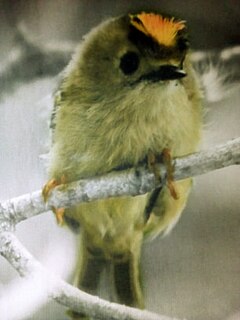 W
WThe Azores chaffinch is a small passerine bird in the finch family Fringillidae. It is a subspecies of the common chaffinch that is endemic to the Portuguese archipelago of the Azores, part of Macaronesia in the North Atlantic Ocean. It is locally known as the tentilhão or sachão.
 W
WThe Azores bullfinch, also known as the São Miguel bullfinch, or locally in Portuguese as the priolo, is an endangered passerine bird in the true finch family. It is endemic to São Miguel Island, in the Azores archipelago of Macaronesia in the North Atlantic Ocean.
 W
WThe Santa Maria goldcrest, Regulus regulus sanctaemariae, Estrelinha-de-poupa in Portuguese, is a very small passerine bird in the kinglet family. It is endemic to Santa Maria Island in the Azores archipelago in the North Atlantic Ocean where it is a non-migratory resident.
 W
WThe greater Azores bullfinch was a large, extinct species of bullfinch in the family Fringillidae that was once endemic to the Azores. It is the first known extinct passerine to be described from the islands. It is the largest known member of its genus based on its skull size, and had a very robust beak reminiscent of that of a parrot. However, the remains are otherwise reminiscent of the extant but highly endangered Azores bullfinch.
 W
WMonteiro's storm petrel is a seabird species from the storm petrel family, Hydrobatidae. The cryptic species was once considered to be conspecific with the band-rumped storm petrel. The species is endemic to the Azores.
 W
WThe Azores wood pigeon, Columba palumbus azorica is an endemic subspecies of the common wood pigeon, located in the Atlantic Azores islands of Portugal. This endemic subspecies is the only live pigeon present in the Laurel forest habitat of the Azores Islands.
 W
WThe grey wagtail is a member of the wagtail family, Motacillidae, measuring around 18–19 cm overall length. The species looks somewhat similar to the yellow wagtail but has the yellow on its underside restricted to the throat and vent. Breeding males have a black throat. The species is widely distributed, with several populations breeding in Eurosiberia and migrating to tropical regions in Asia and Africa. The species is always associated with running water when breeding, although they may use man-made structures near streams for the nest. Outside the breeding season, they may also be seen around lakes, coasts and other watery habitats. Like other wagtails, they frequently wag their tail and fly low with undulations and they have a sharp call that is often given in flight.